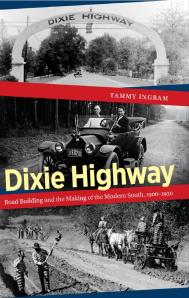 Pop South speaks with Tammy Ingram, Assistant Professor of History at the College of Charleston, and author of Dixie Highway: Road Building and the Making of the Modern South, recently published by UNC Press. Professor Ingram was also kind enough to contribute a guest post for PS that readers of this blog will also find interesting.
Pop South speaks with Tammy Ingram, Assistant Professor of History at the College of Charleston, and author of Dixie Highway: Road Building and the Making of the Modern South, recently published by UNC Press. Professor Ingram was also kind enough to contribute a guest post for PS that readers of this blog will also find interesting.
PS: Briefly, what is the Dixie Highway?
“The Dixie Highway was the first modern interstate highway system in the country, and it lasted from approximately 1915 to 1925. It was originally planned as a single route between Chicago and Miami Beach, but a fierce routing competition transformed it into an ambitious and sophisticated network of nearly 6000 miles of roads looping through the Midwest and South from the Canadian border all the way to Miami Beach.”
PS: How did the Dixie Highway change the South?
“The obvious ways that the Dixie Highway changed the South were economic: It gave farmers easier and more flexible marketing options for their crops, allowed rural southerners access to larger towns and cities, facilitated the Great Migration of rural African Americans, and opened up the South to new tourist-related businesses. It changed the ways in which people moved around in the South. Before the Dixie Highway, roads were entirely local in both scope and governance. But the Dixie Highway challenged that model by making automobile travel an alternative to railroads for long distance trade and travel. In doing so, the Dixie also transformed southern—and national—politics by centralizing control over massive public works projects. During the brief lifespan of the Dixie Highway, road building shifted from the jurisdiction of local authorities into the hands of state and federal bureaucrats who wielded tremendous political power and controlled massive budgets.”
PS: Since this is a blog on the South in pop culture, can you tell us about the ways that the DH entered into American popular culture?

“Although many people have never heard of the Dixie Highway, a century ago it helped to create the modern automobile tourism industry. Gas stations, roadside motels, and tourist attractions were unheard of in most of the country—and certainly in the South—before the Dixie Highway, but by the mid-1920s they lined the route from Michigan to Miami Beach.
The highway also helped to turn the South itself into a destination instead of just an obstacle for wealthy northern and Midwestern tourists bound for Florida resorts. Enterprising southerners marketed everything from antebellum mansions to peach and cotton farms to automobile tourists, and northern businesses named (or in some cases, re-named) their establishments in honor of the Dixie Highway. “Dixie” motels and gas stations in Michigan, Illinois, Indiana, and Ohio were commonplace. So were songs, postcards, magazines, and road maps that advertised (and celebrated) the Dixie Highway.”
PS: As a native Georgian, how do you think being a southerner adds to your perspective on the Dixie Highway?
“I learned how to drive on narrow, rural dirt roads that were not entirely unlike those that comprised the original route of the Dixie Highway. Navigating those roads could be difficult even in the best of weather. When it rained, some of the roads were impassable. We obviously also had modern, paved roads in South Georgia by the 1980s, but we were isolated in other ways: We were among the last places to get things like cable television and even dial-up internet, and the only tourists who ever passed through town were on their way to the beaches in the Florida panhandle. When I discovered the Dixie Highway while doing research for my original dissertation topic on the Great Migration, I think I was drawn to it because the struggles rural people were facing at the turn of the twentieth century felt a little bit familiar to me.”

PS: What projects are you working on next that followers of Pop South would find interesting?
“I’m excited about my next book project, which is tentatively titled Dixie Mafia: Sex, Race, and Organized Crime in the Sunbelt South. It covers a wide array of organized crime activities in the postwar South, but it focuses on a story that has long fascinated me: The murder of Albert Patterson in Phenix City, Alabama in 1954. Like many other small towns situated near military bases, Phenix City’s main industry in those days was vice: Mobsters made tens of millions of dollars a year on gambling and prostitution, and local law enforcement and city leaders were getting a cut of the profits in exchange for their cooperation. Patterson became a target for the mob because he ran for attorney general and promised to go after them. But they went after him, instead. It’s a fascinating story, and all the more so when you consider it within the context of the Civil Rights Movement and the Cold War.”

[…] On the Dixie Highway with Tammy Ingram […]